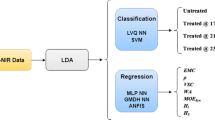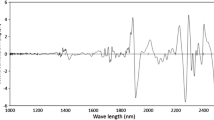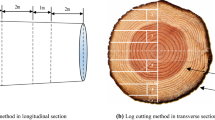Abstract
Predicting the properties of structural timber using a rapid and reliable non-destructive method is a critical quality control task in production. This study investigates using infrared spectroscopy for predicting the density, moduli of elasticity (MOE) and rupture (MOR) of two structural softwoods. Because the produced timber is sometimes planed during manufacturing resulting in a smooth surface finish, the effect of wood surface roughness on prediction accuracy of timber properties was also investigated. Accordingly, infrared spectroscopy experiments were carried out on Douglas-fir and Western hemlock specimens having a rough and smooth surface. In addition, the effect of the infrared spectroscopy range on the predictive models was studied. Data in the visible infrared (VIS), near-infrared (NIR), and the combined VIS and NIR range were used for properties prediction. The acquired infrared data were processed using principal component analysis (PCA) for data reduction and feature selection. The output of PCA was then fed into an adaptive neuro-fuzzy inference system (ANFIS), multilayer perceptron (MLP) neural network (NN) and partial least square (PLS) regression model. The results showed that the wood surface finish, range of infrared data, and the type of machine learning model impact the prediction accuracy. ANFIS showed superior performance to MLP NN and PLS model for properties prediction. In addition, NIR data acquired from rough surface resulted in better prediction accuracy, which suggests that an infrared spectroscopy test should be performed prior to surface planing. The proposed models yield better accuracy for predicting the MOE and MOR than wood density.











Similar content being viewed by others
References
Acquah GE, Essien C, Via BK, Billor N, Eckhardt LG (2018) Estimating the basic density and mechanical properties of elite loblolly pine families with near infrared spectroscopy. Forest Sci 64(2):149–158
Andrade C, Trugilho P, Napoli A, Vieira R, Lima J, Sousa L (2010) Estimation of the mechanical properties of wood from Eucalyptus urophylla using near infrared spectroscopy. Cerne 16(3):291–298
Avramidis S, Iliadis L (2005) Predicting wood thermal conductivity using artificial neural networks. Wood Fiber Sci 37(4):682–690
Alves A, Santos A, Rozenberg P, Pâques LE, Charpentier JP, Schwanninger M, Rodrigues J (2012) A common near infrared—based partial least squares regression model for the prediction of wood density of Pinus pinaster and Larix× eurolepis. Wood Sci Technol 46(1–3):157–175
Balabin RM, Safieva RZ, Lomakina EI (2010) Gasoline classification using near infrared (NIR) spectroscopy data: comparison of multivariate techniques. Anal Chim Acta 671(1–2):27–35
Balabin RM, Lomakina EI (2011) Support vector machine regression (SVR/LS-SVM)—an alternative to neural networks (ANN) for analytical chemistry? Comparison of nonlinear methods on near infrared (NIR) spectroscopy data. Analyst 136(8):1703–1712
Beall FC (2002) Overview of the use of ultrasonic technologies in research on wood properties. Wood Sci Technol 36(3):197–212
Bokobza L (2002) Origin of near-infrared absorption bands. In: Siesler HW, Ozaki Y, Kawata S, Heise HM (eds) Near infrared spectroscopy. Wiley-VCH, Weinheim, p 11
Cooper PA, Jeremic D, Radivojevic S, Ung YT, Leblon B (2011) Potential of near-infrared to characterize wood products. Can J For Res 41(11):2150–2157
Costa EV, Rocha MF, Hein PR, Amaral EA, Santos LM, Brandão LE et al (2018) Influence of spectral acquisition technique and wood anisotropy on the statistics of predictive near infrared–based models for wood density. J Near Infrared Spectrosc 26(2):106–116
Dackermann U, Crews K, Kasal B, Li J, Riggio M, Rinn F, Tannert T (2014) In situ assessment of structural timber using stress-wave measurements. Mater Struct 47(5):787–803
Dahlen J, Diaz I, Schimleck L, Jones P (2017) Near-infrared spectroscopy prediction of southern pine No. 2 lumber physical and mechanical properties. Wood Sci Technol 51:309–322. https://doi.org/10.1007/s00226-016-0874-5
Defo M, Taylor M, Bond B (2007) Determination of moisture content and density of fresh-sawn red oak timber by near-infrared spectroscopy. Forest Prod J 57(5):68–72
dos Santos LM, Amaral EA, Nieri EM, Costa EVS, Trugilho PF, Calegário N, Hein PRG (2020) Estimating wood moisture by near infrared spectroscopy: testing acquisition methods and wood surfaces qualities. Wood Mater Sci Eng. https://doi.org/10.1080/17480272.2020.1768143
Evans R, Stringer S, Kibblewhite RP (2000) Variation of microfibril angle, density and fibre orientation in twenty-nine Eucalyptus nitens trees. Appita J 53:450–457
Fathi H, Kazemirad S, Nasir V (2021) Lamb wave propagation method for nondestructive characterization of the elastic properties of wood. Appl Acoust 171:107565. https://doi.org/10.1016/j.apacoust.2020.107565
Fathi H, Nasir V, Kazemirad S (2020) Prediction of the mechanical properties of wood using guided wave propagation and machine learning. Constr Build Mater 262:120848. https://doi.org/10.1016/j.conbuildmat.2020.120848
Fackler K, Schwanninger M (2010) Polysaccharide degradation and lignin modification during brown rot of spruce wood: a polarised Fourier transform near infrared study. J Near Infrared Spectrosc 18(6):403–416
Feio A, Machado JS (2015) In-situ assessment of timber structural members: combining information from visual strength grading and NDT/SDT methods—a review. Constr Build Mater 101:1157–1165
Forest Products Laboratory (1999) Wood handbook—wood as an engineering material. General Technical Report. FPL-GTR-113. In: US Department of Agriculture, Forest Service, Forest Products Laboratory, Madison, Wisconsin
Fujimoto T, Yamamoto H, Tsuchikawa S (2007) Estimation of wood stiffness and strength properties of hybrid larch by near-infrared spectroscopy. Appl Spectrosc 61(8):882–888
Fujimoto T, Kurata Y, Matsumoto K, Tsuchikawa S (2008) Application of near infrared spectroscopy for estimating wood mechanical properties of small clear and full-length lumber specimens. J Near Infrared Spectrosc 16(6):529–537
Galvão RK, Araujo MC, José GE, Pontes MJ, Silva EC, Saldanha TC (2005) A method for calibration and validation subset partitioning. Talanta 67(4):736–740
Gaspar F, Lopes J, Cruz H, Schwanninger M, Rodrigues J (2009) Application of near infrared spectroscopy and multivariate data analysis for the evaluation of glue lines of untreated and copper azole treated laminated timber before and after ageing. Polym Degrad Stab 94(7):1061–1071
Glass SV, Zelinka SL, Johnson JA (2014) Investigation of historic equilibrium moisture content data from the Forest Products Laboratory. In: USDA forest service, forest products laboratory, general technical report, FPL-GTR-229, vol 37, pp 1–37
Haddadi A, Leblon B, Pirouz Z, Nader J, Groves K (2016) Prediction of wood properties for thawed and frozen logs of quaking aspen, balsam poplar, and black spruce from near-infrared hyperspectral images. Wood Sci Technol 50(2):221–243
Hein PRG, Lima JT, Chaix G (2009) Robustness of models based on near infrared spectra to predict the basic density in Eucalyptus urophylla wood. J Near Infrared Spectrosc 17(3):141–150
Hein PR (2010) Multivariate regression methods for estimating basic density in Eucalyptus wood from near infrared spectroscopic data. Cerne 16:90–96
Hwang SW, Horikawa Y, Lee WH, Sugiyama J (2016) Identification of Pinus species related to historic architecture in Korea using NIR chemometric approaches. J Wood Sci 62(2):156–167
Johnson GR, Gartner BL (2006) Genetic variation in basic density and modulus of elasticity of coastal Douglas-fir. Tree Genet Genomes 3(1):25–33
Jones PD, Schimleck LR, So CL, Clark A III, Daniels RF (2007) High resolution scanning of radial strips cut from increment cores by near infrared spectroscopy. IAWA J 28(4):473–484
Kelley S, Rials TG, Snell R, Groom LH, Sluiter A (2004) Use of near infrared spectroscopy to measure the chemical and mechanical properties of solid wood. Wood Sci Technol 38(4):257–276
Li X, Ju S, Luo T, Li M (2020) Effect of moisture content on propagation characteristics of acoustic emission signal of Pinus massoniana Lamb. Eur J Wood Prod 78(1):185–191
Lin H, Zhao J, Sun L, Chen Q, Zhou F (2011) Freshness measurement of eggs using near infrared (NIR) spectroscopy and multivariate data analysis. Innov Food Sci Emerg Technol 12(2):182–186
Liu C (2011) Use of confocal profilometry to quantify erosion of wood and screen chemicals for their ability to photostabilize wood (Doctoral dissertation, University of British Columbia)
López G, Basterra LA, Acuña L (2013) Estimation of wood density using infrared thermography. Constr Build Mater 42:29–32
Middleton GR, Munro BD (eds) (2001) Second-growth western hemlock: product yields & attributes related to stand density. Forintek Canada Corporation
Mitsui K, Inagaki T, Tsuchikawa S (2008) Monitoring of hydroxyl groups in wood during heat treatment using NIR spectroscopy. Biomacromol 9(1):286–288
Mora C, Schimleck L (2010) Kernel regression methods for the prediction of wood properties of Pinus taeda using near infrared spectroscopy. Wood Sci Technol 44:561–578
Nasir V, Nourian S, Avramidis S, Cool J (2018) Prediction of physical and mechanical properties of thermally modified wood based on color change evaluated by means of ‘group method of data handling’ (GMDH) neural network. Holzforschung 73(4):381–392
Nasir V, Nourian S, Avramidis S, Cool J (2019a) Stress wave evaluation by accelerometer and acoustic emission sensor for thermally modified wood classification using three types of neural networks. Eur J Wood Prod 77(1):45–55
Nasir V, Nourian S, Avramidis S, Cool J (2019b) Stress wave evaluation for predicting the properties of thermally modified wood using neuro-fuzzy and neural network modeling. Holzforschung 73(9):827–838
Nasir V, Nourian S, Zhou Z, Rahimi S, Avramidis S, Cool J (2019) Classification and characterization of thermally modified timber using visible and near-infrared spectroscopy and artificial neural networks: a comparative study on the performance of different NDE methods and ANNs. Wood Sci Technol 53(5):1093–1109
Nasir V, Nourian S, Avramidis S, Cool J (2019c) Classification of thermally treated wood using machine learning techniques. Wood Sci Technol 53(1):275–288
Nasir V, Cool J, Sassani F (2019) Acoustic emission monitoring of sawing process: artificial intelligence approach for optimal sensory feature selection. Int J Adv Manuf Technol 102(9–12):4179–4197
Nasir V, Cool J (2020) Intelligent wood machining monitoring using vibration signals combined with self-organizing maps for automatic feature selection. Int J Adv Manuf Technol 2020:1–15
Osborne NL, Høibø ØA, Maguire DA (2016) Estimating the density of coast Douglas-fir wood samples at different moisture contents using medical X-ray computed tomography. Comput Electron Agric 127:50–55
Palma P, Steiger R (2020) Structural health monitoring of timber structures—review of available methods and case studies. Constr Build Mater 248:118528
Perlin LP, de Andrade Pintodo Valle RCA (2019) Ultrasonic tomography in wood with anisotropy consideration. Constr Build Mater 229:116958
Piazza M, Riggio M (2008) Visual strength-grading and NDT of timber in traditional structures. J Build Appraisal 3(4):267–296
Popescu CM, Navi P, Peña MIP, Popescu MC (2018) Structural changes of wood during hydro-thermal and thermal treatments evaluated through NIR spectroscopy and principal component analysis. Spectrochim Acta Part A Mol Biomol Spectrosc 191:405–412
Riggio M, Sandak J, Sandak A, Pauliny D, Babiński L (2014) Analysis and prediction of selected mechanical/dynamic properties of wood after short and long-term waterlogging. Constr Build Mater 68:444–454
Riggio M, Anthony RW, Augelli F, Kasal B, Lechner T, Muller W, Tannert T (2014) In situ assessment of structural timber using non-destructive techniques. Mater Struct 47(5):749–766
Rinnan Å (2014) Pre-processing in vibrational spectroscopy—when, why and how. Anal Methods 6(18):7124–7129
Rosipal R, Trejo LJ (2001) Kernel partial least squares regression in reproducing kernel Hilbert space. J Mach Learn Res 2:97–123
Sandak J, Sandak A, Riggio M (2015a) Multivariate analysis of multi-sensor data for assessment of timber structures: principles and applications. Constr Build Mater 101:1172–1180
Sandak A, Sandak J, Riggio M (2015b) Estimation of physical and mechanical properties of timber members in service by means of infrared spectroscopy. Constr Build Mater 101:1197–1205
Savitzky A, Golay MJ (1964) Smoothing and differentiation of data by simplified least squares procedures. Anal Chem 36(8):1627–1639
Schimleck LR, Evans R, Matheson AC (2002) Estimation of Pinus radiata D. Don clear wood properties by near-infrared spectroscopy. J Wood Sci 48(2):132–137
Schimleck L, Doran J, Rimbawanto A (2003) Near infrared spectroscopy for cost effective screening of foliar oil characteristics in a Melaleuca cajuputi breeding population. J Agric Food Chem 51(9):2433–2437
Schimleck LR, Evans R, Jones PD, Daniels RF, Peter GF, Clark A III (2005) Estimation of microfibril angle and stiffness by near infrared spectroscopy using sample sets having limited wood density variation. IAWA J 26(2):175–187
Schimleck LR, Jones PD, Clark A, Daniels RF, Peter GF (2005) Near infrared spectroscopy for the non-destructive estimation of clear wood properties of Pinus taeda L. from the Southern USA. Forest Prod J 55(12):21–28
Schimleck L, Matos JL, Trianoski R, Prata J (2018) Comparison of methods for estimating mechanical properties of wood by NIR spectroscopy. J Spectrosc 2018:218
Schimleck L, Dahlen J, Yoon SC, Lawrence KC, Jones PD (2018) Prediction of Douglas-fir lumber properties: comparison between a bench top near-infrared spectrometer and hyperspectral imaging system. Appl Sci 8(12):2602
Schwanninger M, Hinterstoisser B, Gradinger C, Messner K, Fackler K (2004) Examination of spruce wood biodegraded by Ceriporiopsis subvermispora using near and mid infrared spectroscopy. J Near Infrared Spectrosc 12(6):397–409
Schwanninger M, Rodrigues JC, Fackler K (2011) A review of band assignments in near infrared spectra of wood and wood components. J Near Infrared Spectrosc 19(5):287–308
Sayyad Amin J, Rajabi Kuyakhi H, Kashiwao T, Bahadori A (2019) Development of ANFIS models for polycyclic aromatic hydrocarbons (PAHs) formation in sea sediment. Pet Sci Technol 37(6):679–686
Softwood Species Profile (2020) https://www.naturallywood.com/forest-products-species/softwood-species. Accessed 10 June 2020
Thumm A, Meder R (2001) Stiffness prediction of radiata pine clear wood test pieces using near infrared spectroscopy. J Near Infrared Spectrosc 11:137–144
Thygesen LG, Lundqvist SO (2000) NIR measurement of moisture content in wood under unstable temperature conditions. Part 1. Thermal effects in near infrared spectra of wood. J Near Infrared Spectrosc 8(3):183–189
Todorovic N, Popovic Z, Milic G (2015) Estimation of quality of thermally modified beech wood with red heartwood by FT-NIR spectroscopy. Wood Sci Technol 49(3):527–549
Tsuchikawa S, Siesler H (2003) Near-infrared spectroscopic monitoring of the diffusion process of deuterium-labeled molecules in wood. Part II: Hardwood. Appl Spectrosc 57(6):675–681
Tsuchikawa S, Kobori H (2015) A review of recent application of near infrared spectroscopy to wood science and technology. J Wood Sci 61(3):213–220
Via BK, Shupe TF, Groom LH, Stine M, So CL (2003) Multivariate modelling of density, strength and stiffness from near infrared spectra for mature, juvenile and pith wood of longleaf pine (Pinus palustris). J Near Infrared Spectrosc 11(5):365–378
Walker JCF (1993) Sawmilling. Primary wood processing. Springer, Dordrecht, pp 197–246
Wang Q, Yang S, Jiang M, Cao J (2019) Non-destructive detection of density and moisture content of heartwood and sapwood based on X-ray computed tomography (X-CT) technology. Eur J Wood Prod 77(6):1053–1062
Wold S, Esbensen K, Geladi P (1987) Principal component analysis. Chemometrics Intell Lab Syst 2(1–3):37–52
Xu Q, Qin M, Ni Y, Defo M, Dalpke B, Sherson G (2011) Predictions of wood density and module of elasticity of balsam fir (Abies balsamea) and black spruce (Picea mariana) from near infrared spectral analyses. Can J For Res 41(2):352–358
Zhang M, Liu Y, Yang Z (2015) Correlation of near infrared spectroscopy measurements with the surface roughness of wood. BioResources 10(4):6953–6960
Zhou Z, Rahimi S, Avramidis S (2020) On-line species identification of green hem-fir timber mix based on near infrared spectroscopy and chemometrics. Eur J Wood Prod 78(1):151–160
Zhou Z, Rahimi S, Avramidis S, Fang Y (2020) Species-and moisture-based sorting of green timber mix with near infrared spectroscopy. BioResources 15(1):317–330
Zobel BJ, Jett JB (1995) The importance of wood density (specific gravity) and its component parts. Genetics of wood production. Springer, Berlin, Heidelberg, pp 78–97
Author information
Authors and Affiliations
Corresponding author
Additional information
Publisher's Note
Springer Nature remains neutral with regard to jurisdictional claims in published maps and institutional affiliations.
Rights and permissions
About this article
Cite this article
Ayanleye, S., Nasir, V., Avramidis, S. et al. Effect of wood surface roughness on prediction of structural timber properties by infrared spectroscopy using ANFIS, ANN and PLS regression. Eur. J. Wood Prod. 79, 101–115 (2021). https://doi.org/10.1007/s00107-020-01621-x
Received:
Accepted:
Published:
Issue Date:
DOI: https://doi.org/10.1007/s00107-020-01621-x




